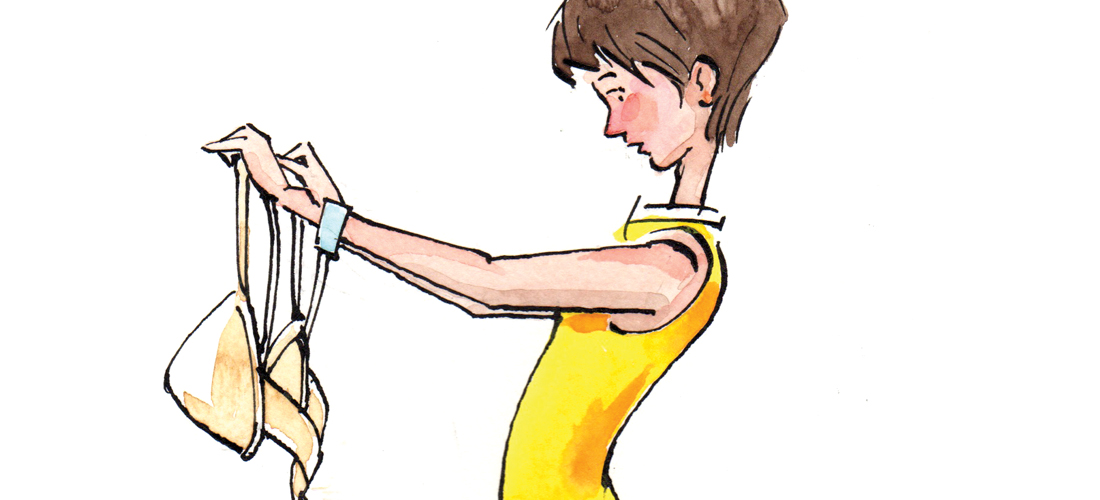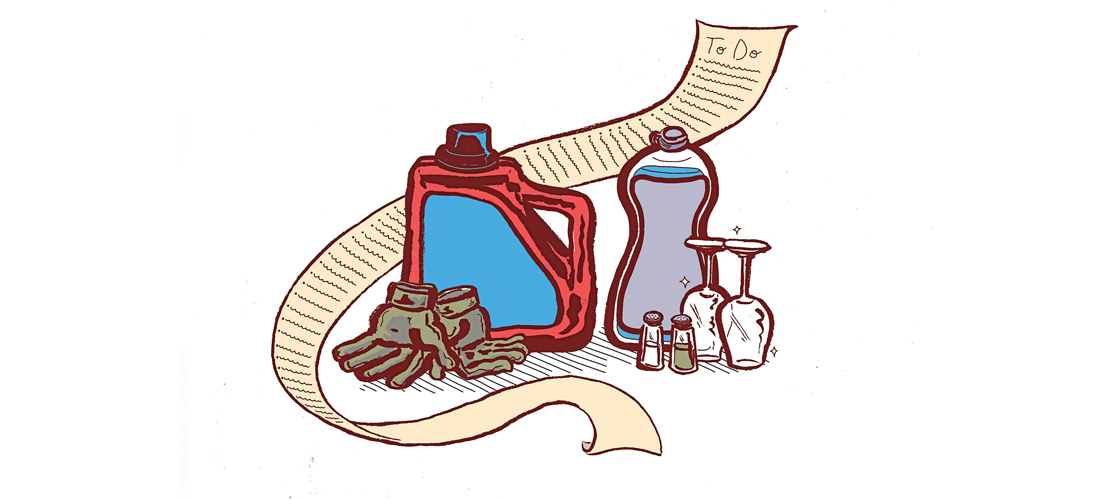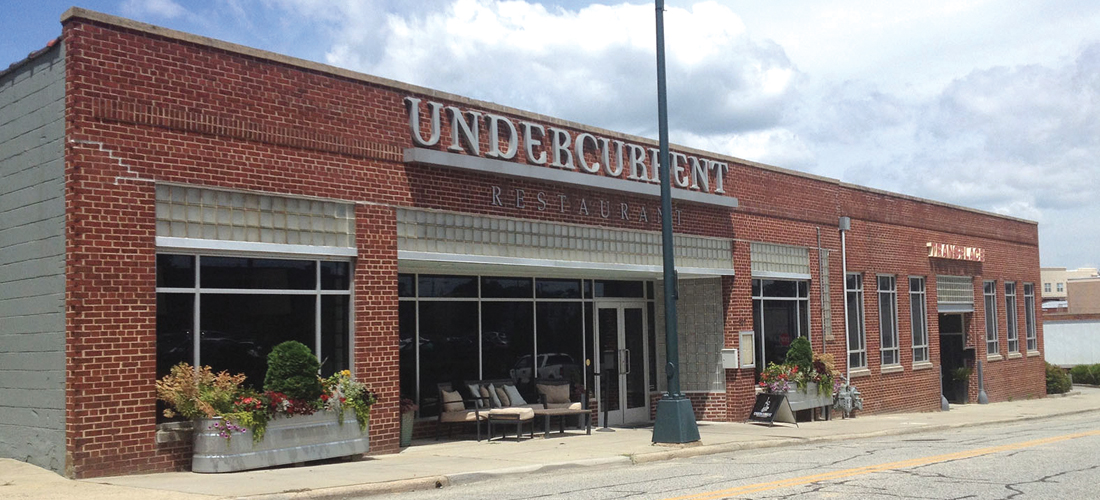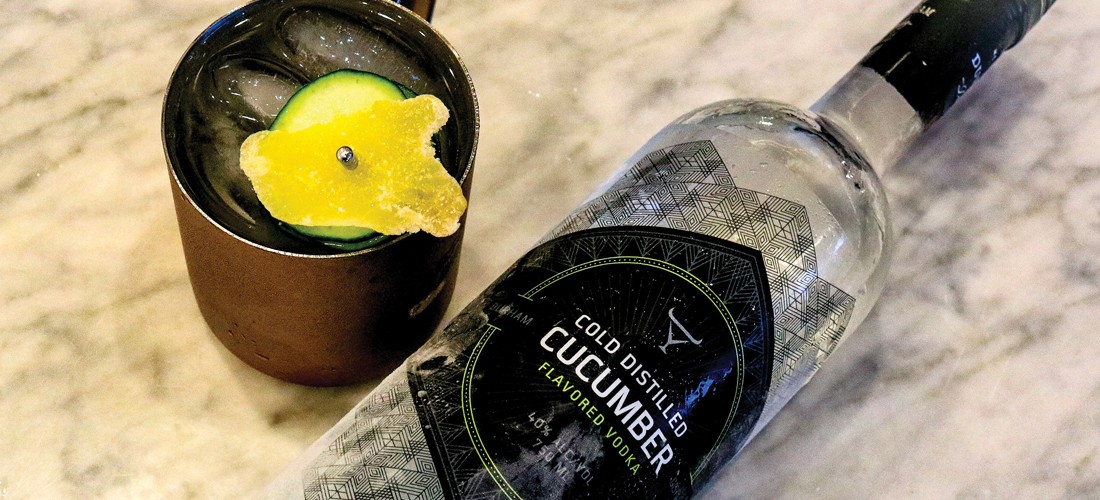Painting the Town
From downtown to Midtown and beyond, Marty Kotis is putting
 By Maria Johnson • Photographs by Amy Freeman
By Maria Johnson • Photographs by Amy Freeman
He’s not an artist.
He never studied art. Never collected it. Never particularly noticed it.
Heck, he wasn’t even a comic book kid.
But in the last two years, Greensboro real estate developer Marty Kotis — an only child who followed his father Bill into the business — has emerged as a champion of street art, splashy outdoor art writ large, often in the form of spray-painted murals.
This isn’t some guy noodling around on a bridge with a can of Rust-Oleum.
This is a deep-pockets patron who’s pushing polished, professional work.
Done with permission.
And paychecks for internationally known artists.
As a result, Greensboro perches on the front row of a global art movement.
“The really weird thing is seeing these artists from all over the world in Greensboro, North Carolina – like, little ole Greensboro,” says local street artist Brian Lewis, who is professionally known as JEKS. “You know, we’re a small town compared to the rest of the world, but we have some of the best murals. It’s cool to have that caliber of art here”
To earn that distinction for the city, Kotis has shelled out a chunk of change — estimates climb well into six figures — for more than 40 pieces, ranging from small graffiti “throw-ups” to beautifully nuanced portraits that jump out from big walls, many of them in the Kotis stronghold of Midtown.
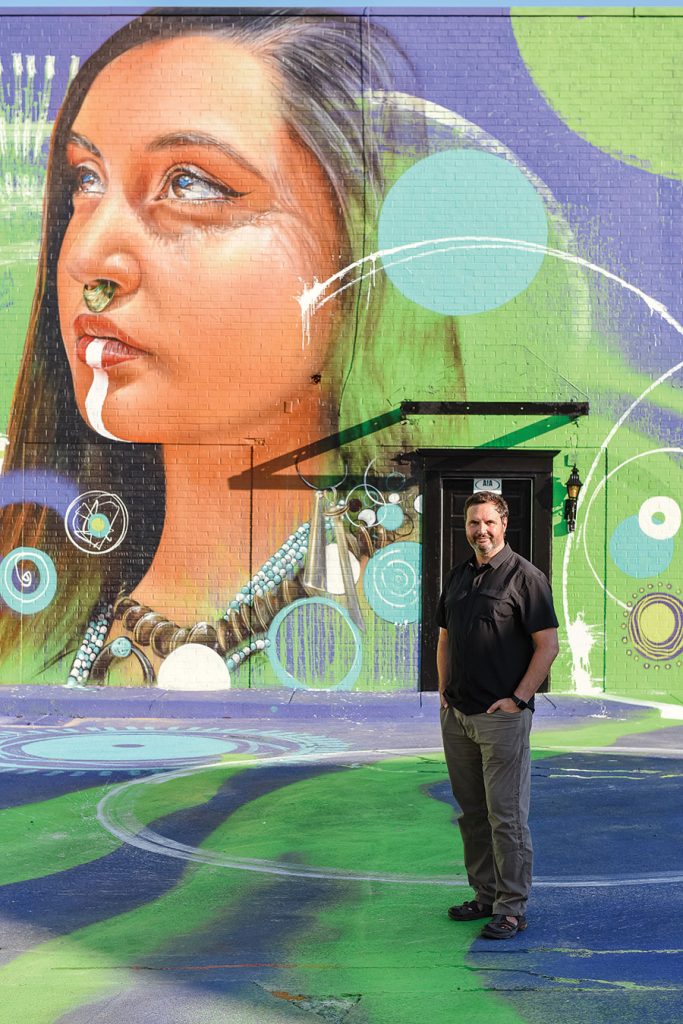
That a developer would pay for more than necessities in his buildings is unusual. That he would pay for adornments that last, on average, 10 years before they need refreshing or painting over, is remarkable. But Kotis sees his investment as an extension of what he’s been doing since he joined his dad’s business in the mid-1990s.
“I’ve always been interested in changing the landscape of a city,” he says. “I’ve been curating buildings for a long time. Now, I’m curating art.”
Bearded yet boyish at age 49, he tosses off the names of street artists — usually one-word handles such as Adnate, Belin, DOES, DAAS and DANK— with ease.
He checks his Instagram feed several times a day to see what they’re up to. He follows individuals and aggregators who gather and share images. Greensboro swims in that sea, too. Every time a significant piece goes up, the city gets tagged in posts that are cast upon the waters of social media.
“That’s shared all over the world,” says Kotis. “We had a guy come in from New York just to look at our art. He’s a freelance writer who covers a of lot street art. He pointed out that our pieces are much larger than what you would find in New York, and our art tends to stay up longer.”
Kotis has tinkered with interior and exterior art since 2010 when he bought, renamed and revamped the Darryl’s restaurant on Gate City Boulevard, the last location of a once-popular chain that was born in North Carolina.

He hired local artists to paint witty bar signs and vignettes when he re-opened the restaurant as Darryl’s Wood Fired Grill.
He expanded with creative touches at his Midtown restaurants including Burger Warfare (see military robot sculptures and a bar crafted from .50-caliber machine gun shells), the now-defunct Marshall Free House and its short-lived replacement, The Traveled Farmer.
He waded into large-scale acrylic art in 2016 after local entrepreneur Ryan Saunders, who founded a venture called Create Your City, approached him about painting one of the buildings that Kotis and his father own at the corner of Friendly Avenue and Davie Street.
Kotis gave the nod, and a woman named Taylor White, of Raleigh, painted a pair of intertwined purple hands on a wall facing GreenHill gallery, which funded the project.
Kotis was intrigued. He became a student of outdoor walls. He noticed street art when he was traveling, and he started planning trips around it.
“I went to Berlin in 2016 and saw how amazing some of these pieces can be, really world-class art,” he says. “I took a stenciling class just to understand the technique. I traveled to New York, Las Vegas, Houston and Miami to see some different art, too. I thought, ‘I want to bring this to Greensboro.’”
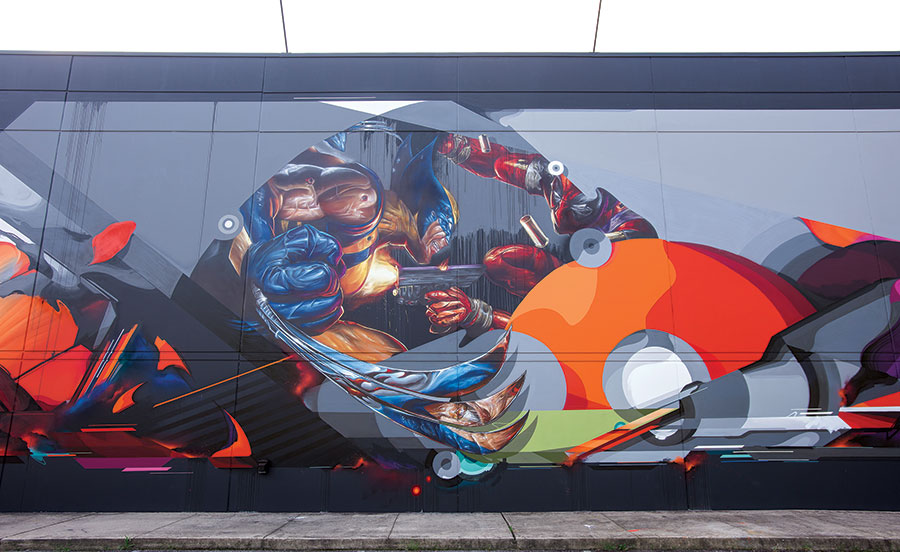
The following year, he commissioned artist Steven Darling, who lives part time in Winston-Salem, to paint lettering and a kaleidoscopic lollipop on the side of a downtown building where Kotis plans to install a charter school. The building, at the corner of Church and East Washington streets, once held a candy company and, later, human-services agencies.
Kotis struck again when he lassoed local, national and international artists to decorate the industrial surfaces at his Tracks Bazaar and beer garden on eight-plus acres that were once occupied by Brooks Lumber Co. near the South Eugene Street bridge. He envisions the complex as part of a larger arts district along Gate City Boulevard.
Hungry for more wall space, Kotis pivoted north to the epicenter of his holdings in Midtown, a swath along Battleground Avenue discernable by its outdoor bistro lights, buildings with heavy cornices and ornate brickwork.
He recruited some heavy-duty names.
He flew in Australian artist Matt Last, who goes by the name Adnate and who specializes in painting indigenous people, to do a portrait of a Lumbee man on the side of the Midtown Financial Advisors building.
Kotis, who serves on the UNC Board of Governors, says he wanted to honor the Lumbee, the largest tribe east of the Mississippi River, after he delivered a commencement address at UNC Pembroke last year.
”It was very welcoming community,” says Kotis.
Adnate did a second portrait, of a young Lumbee woman, on a bridge abutment next to Tracks. The bridge is along the Atlantic & Yadkin Greenway, which, when completed, will thread by Tracks Bazaar and Midtown, enabling walkers and cyclists to take in the art that Kotis is assembling along the blacktop spine.
“You’ll have this outdoor gallery stroll,” he says. “It’s only a mile and a half as the crow flies.”

Among the sights that pedestrians will see: The huge pieces that Kotis commissioned earlier this year on sides of RED Cinemas in Midtown. The theater’s south-facing wall is a futuristic vision of Tokyo — complete with flying cars and a holographic geisha — painted by British artist Dan Kitchener, aka DANK.
To cover the north wall, Kotis brought in three famous street artists.
Joos van Barneveld, aka digitaldoes or simply DOES, from the Netherlands, painted the abstract background.
Adnate, of Australia, returned to do the Marvel Comics movie characters Deadpool and Wolverine.
Spanish artist Miguel Ángel Belinchón Bujes, better known as Belin, rendered Wonder Woman, her bracelets crossed in defiance of evil.
Kotis adores the Wonder Woman portrait.
“I would argue that’s the best photo-realistic mural I’ve seen in the entire world,” he says. “When he finished that, we were all amazed. He did that with no projections, no markings.”

While he was here, Belin also did a large cubist painting of a woman inside the former Ham’s Lakeside, which Kotis plans to reopen as a second Darryl’s Wood Fired Grill next spring. Meanwhile, the artist DOES executed an abstract design, suggesting the interplay of light and water, across the back of the restaurant on East Cone Boulevard.
If it sounds as if Kotis spends a lot of time with the artists, he does.
“I don’t delegate the architecture of my buildings, and I don’t delegate this either,” he says. “It’s something I enjoy.”
For Kotis, the pleasure starts with picking a wall. He mulls over which artists have a style and subject matter that fit the space.
Many of his buildings — he owns 27 in Midtown alone — provide ideal workspaces, with blah two-story walls that back up to the retired railroad tracks.
“I enjoy taking these really ugly areas and making them among the nicest parts of the city,” he says.
He reaches out to the artists himself, spending hours pitching ideas, trading images, selling himself and Greensboro. One of his advantages, he says, is that he gives artists an unusual degree of freedom.
“I don’t say, ‘Hey, can you paint my grandmother on the side of this building and do it with these colors?’ ” he says.
He asks about their dream projects.
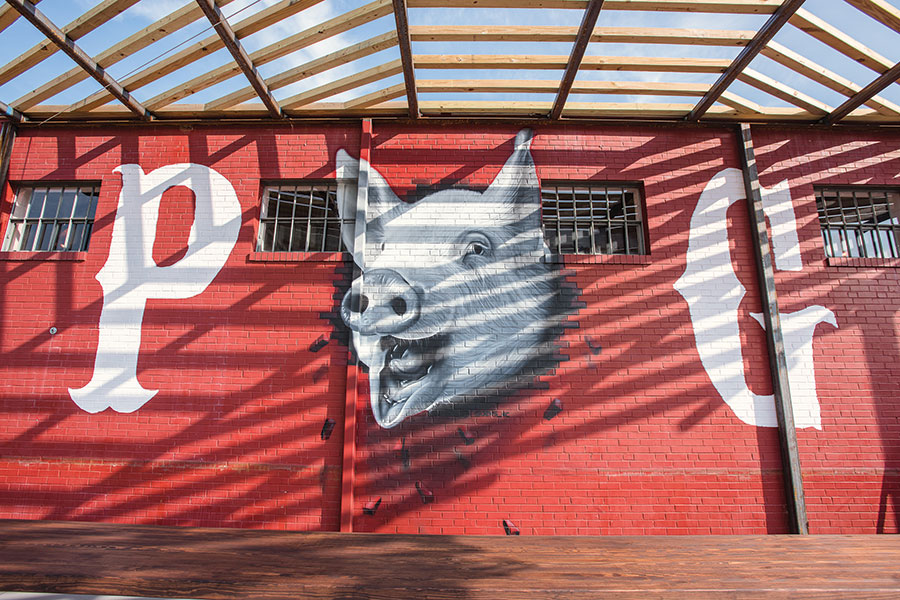
“If we can do something they’ve been burning to do, we get a much better installation than if they slap up a wall they’ve done 30 times,” he says.
Kotis makes an attractive offer: a wall prepped to the artist’s specs; airfare for the artist and sometimes for family members; accommodations at hotels or Airbnbs; meals; rental cars; local assistants; project lighting; mechanical lifts and, of course, paint.
That’s in addition to an artist fee for painting, which can run from thousands to tens of thousands of dollars, depending on the stature of the artist.
Kotis often pays for wrap-and-reveal parties at the end of projects.
A few weeks ago, he oversaw an ambitious project at 1205 West Bessemer Avenue, a brick office building in Midtown. Kotis plans to convert the property to an office/residential hybrid with Airbnb space.
To transform the building from ho-hum to hot-damn, he brought back his go-to artist, Adnate from Australia, to paint three portraits — two Cherokee sisters on one wall and an Aboriginal man on the other side of the building, representing the belief that first-nation people communicated through dreams.
Adnate had expressed interest in working with artist Eric Mangen of Luxembourg, so Kotis hired him to do the background. Mangen bandied about the idea of using large fire extinguishers — similar to the 4-foot models used at airports — to douse the building with waves of purple and lime green paint.
Kotis suggested another way.
“I said, ‘Do you think you could paint with a fire truck?’ He said, ‘Well, that’s never been done in the world.’ I said, ‘Let me see what I can do.’”
Kotis bought a used fire truck. He rigged it with special hoses and nozzles for paint. Mangen was floored.
“That’s the fun part, too,” says Kotis. “The challenge of seeing if we can do something that’s never been done. How do we create that wow factor?”
Kotis admits he was anxious about the building’s purple and green color scheme. So were his tenants. One woman walked into the parking lot while the purple paint was going up. She was talking on her cell phone.
“She said, ‘This is the ugliest crap you’ve ever seen in your life,’ ” says Kotis. “Then she looked over and saw us and was like, ‘Oh, hey!’ The next day, we added the green. Sometimes, when you do this, it can be like watching sausage-making.”
Kotis paid a team of videographers, including one from Los Angeles, to record the process. He pushed the finished clip out on Instagram and Facebook. (See O.Henry’s Facebook page to view the clip). He routinely posts glowing testimonials by out-of-town artists to boost his profile as an employer— and, at the same time, enhance Greensboro’s street cred.
He makes no apologies for importing talent, which has caused some grumbling among local artists. In that regard, Kotis likens himself to the Greensboro Coliseum.
”You wouldn’t say, ‘Well, let’s have only local artists at the Coliseum.’ That’s crazy. You’re taking an art form and letting people see it and appreciate it,” he says. “Also, these local artists have a chance to come out and watch the techniques and see what someone is doing.”
Saunders, the arts entrepreneur who first talked Kotis into a large-scale mural, agrees that bringing big-name artists to Greensboro raises the bar for local practitioners, whom Kotis continues to hire.
“I think it’s extremely important what he’s doing,” Saunders says. “Greensboro is on-trend with street art. It’s happening all over the world, but in terms of a city this size, we’re ahead of the curve.”
Kotis notes that others are propelling street art in Greensboro. The Greensboro Mural Project focuses on collaborative painting.
Phillip Marsh, of Rockers Print Shop, promotes and paints street art.
The city of Greensboro has gotten in on the act, too.
Recently, the city hired an artist from the Netherlands, David Louf, aka Mr. June, to paint the concrete dome of the Mitchell Water Treatment Plant in the Midtown area.
The city also paid the street artist known as DAAS to paint two panels on a parking deck on Bellemeade Street. During that job, Kotis chatted up DAAS, who lives in Japan and the United States., and gave him another gig: painting a young African-American space girl on a brick wall at Tracks.
Kotis’s proactive approach is catching, says Josh Sherrick, the city’s superintendent of arts and events.
“Marty doesn’t just talk about it; he does it. He puts his money where his mouth is,” says Sherrick. “Seeing these walls done with speed and efficiency . . . it opens your eyes to what we can do from the government side.”
Kotis isn’t finished.
He plans to add more street art to his Midtown holdings, including a brand new standalone building at the intersection of Pembroke Road and Battleground Avenue. The health food restaurant Corelife Eatery will open there later this year. Kotis made sure the outer walls included insets for murals.
He wants the Greek artist Insane51 to do some provocative work at his
Pig Pounder Brewery.
He’d like to bring back the Wonder Woman artist Belin to erect a sizable sculpture in Midtown.
Farther up Battleground, he’ll probably add some street art to the Mattress Warehouse building that he owns. When he constructs shops and a mountain bike park behind the mattress store, he’ll deck that with street art.
The same goes for a new brick building slated to go across the street from the mattress place, a wedge of land that’s home to a convenience store now.
The Roses shopping center on East Cone Boulevard — that’s his, too — will not escape roller, brush and nozzle.
His senior living complex on Whitehurst Road will sport outdoor art, probably on the back of a building that used to house Refz bar and grill.
“That’ll be more subtle,’ he says.
He would like to do something entirely different with the small shopping strip that used to house Mahi’s Seafood Restaurant on Lawndale Drive.
Kotis wants to bring back DOES to turn the whole building into a piece of art. He visualizes the vacant storefronts glowing from within, maybe with video screens. The exterior would be painted and lit up. Passers-by on Lawndale Drive and the new urban loop would simply behold, not enter, the building.
Soon, Kotis says, he and his 15-year-old son Alex will experiment on the building with some drip painting techniques.
Kotis swears he doesn’t want to be an artist himself.
“My art is place-making,” he says. “It’s a creative outlet. It gives me new inspiration and ideas, and it keeps things interesting for me. When I have fascinating projects, and interesting people to work with, and a chance to something world-class, that inspires me.” OH
Maria Johnson is a contributing editor of O.Henry.
Watta Baby!
Kiddie swimmer makes a splash
The Baby is only a few months old — in appearance and in fact — and already he’s a landmark, this chubby-cheeked, blue-eyed, bare-chested tyke who hovers on a wall facing Battleground Avenue near Pembroke Road.
He appears to swim under azure water, holding a can of spray paint in his right hand, in the style of the infant who clenches a dollar on the iconic album cover of Nirvana’s Nevermind.
Thousands of people drive by “The Baby” every day and grin. Groups of friends pose in front of the rosy pink tot. They snap pics, post, like, repost.
He has become somewhat of a social media sensation, this bubble-blowing babe, and he has buoyed the career of the Greensboro artist who created him.
Brian Lewis, aka JEKS, has been overwhelmed by the response to the aqua kiddie that he and artist Eric Mangen of Luxembourg painted to life in June.
“People have shown so much love,” says the 35-year-old Lewis, who revived his spray-painting skills last year after a lengthy layoff. “I get a comment every day from people saying, ‘Thank you.’ “
The baby was born after real-estate developer Marty Kotis offered Mangen a wall in his Westover Gallery of Shops.
Mangen was in town to paint a psychedelic background for another piece on a Kotis property at 1205 West Bessemer Avenue. Kotis had bought a used fire truck just so Mangen could drench the wall with paint, and Mangen wanted to use the truck again.
Kotis looked for blank walls on his other properties.
He offered Mangen the backside of the building that houses Great Outdoor Provision Co. and Chipotle Mexican Grill, among other businesses.
Mangen grabbed the offer, and Kotis urged him to collaborate with Lewis, whom Kotis had hired for several jobs, mostly notably a portrait of Ryan Gosling’s character in the movie Blade Runner 2049. The mostly monochromatic portrait gazes onto Battleground Avenue from a high spot near the box office at RED Cinemas.
Lewis and Mangen huddled on the quick-draw project at Westover. Mangen was determined to slash bright turquoise paint across the concrete-block wall, which was covered in a solid terra cotta color.
Mangen had no idea what Lewis would paint — street artists are notoriously independent, even when collaborating — but he urged Lewis to depart from his usual gray-scale palette and use screaming pinks that would pop against the turquoise backdrop.
Lewis listened. He’d had some success with color — see a gray-toned hand squeezing a vivid green lime, a work he did with local artist Gina Franco, inside Crafted: The Art of the Taco in downtown Greensboro — but he was relatively new to big, bright photorealistic murals. A Winston-Salem native, he’d grown up on graffiti.
“I fell in love with the medium,” says Lewis. “The rattle cans, there’s nothing like it, you can cover so much ground so quick.”
He loved heavy-metal music, too, and after graduating from high school — where he’d built a portfolio in Advanced Placement Art — he jumped on board as a drummer with the Greensboro based band Bloodjinn and toured for many years before he burned out on the travel and segued into a regular bartending gig. He’d dusted off his spray game in early 2017.
“A good friend, Mitch Cook, he pulled me out of the woodwork and said, ‘Let’s do a job together,’ ” Lewis says.
They teamed up on a piece, riffing on classical statuary, for Rue-Bar in downtown Greensboro.
Lewis honed his mural techniques, with permission, on walls around town, including one at Mother Tucker’s bar on Spring Garden Street.
When street artist Patch Whisky of Charleston, S.C., visited to paint at Kotis’s Tracks Bazaar, he invited Lewis to join him. That’s how Lewis met Kotis, who recommended Lewis to the owner of Riding High Harley-Davidson on NC 68. Lewis embellished an outside wall with a photorealistic dragon. The gray-toned dragon swooped across social media.
More jobs followed for Lewis: Elvis on the side of a friend’s bar in Charlotte; a trip to Pabst Blue Ribbon headquarters in Los Angeles to do indoor murals depicting the brewery’s history; an invitation to Meeting of Styles, a traveling worldwide summit of street artists that lands once a year in Miami.
Then came Ryan Gosling’s stubbly face on the front of the theater in Greensboro. Kotis invited Lewis to mingle with the international team he assembled to paint the sides of the cinema.
To have a supporter like Kotis — who appreciates street art and has the walls and the money to make it happen — is a rare and beautiful thing, says Lewis.
“A term used for a client like that is ‘Unicorn,’ ” he says. “He wants to cover the town, and it’s cool. It’s real cool.”
So, would Lewis stretch himself to create something outrageously pink on the wall at Westover?
Sure.
The night before he painted, Lewis lingered online over stock images of babies, using Photoshop to morph them into a baby with a rattle can on a string. The Nirvana reference came from Lewis’s love of music and the wall’s proximity to BadAxe Boutique, a guitar store.
“It was a point-and-shoot,” says Lewis. “There wasn’t much thought behind it at all except, ‘What’s the best giant thing I can do in a short amount of time?’”
The next day, he climbed onto a lift, rolled a pink base coat over part of Mangen’s background, and freehanded the outline of the baby.
Referring to a gridded image on his cell phone, and using low-pressure spray paint cans designed for street artists, he conjured the cherub square-by-square. Toward the end, he ran out of paint and had to run to Home Depot for pink Rust-Oleum.
The result is an “Awww”-inspiring image that’s bobbing around the world on a wave of likes.
“It’s been humbling. In the beginning, about five or ten people a day were tagging me on Facebook and Instagram,” says Lewis, who goes by JEKS_NC on Instagram.
“I never thought a big pink baby would cause that kind of reaction, but it’s fun. It makes people smile.”
The response has been career fuel for Lewis, who prefers to keep his face hidden in photos so his work remains the focus. You might not recognize his mug in public, but look for the tattoo sleeves that betray his world-as-canvas outlook.
The edge of his right hand bears the word “starving.”
The edge of his left hand says “artist” in the same Gothic font.
When he raises his hands together . . . you get the idea.
The ink was applied earlier this year, Lewis’s way of embracing the question he’d heard for so many years.
“So many people would be like, ‘Are you going to be a starving artist your whole life?’” he says. “I didn’t mind, as long as I was happy. But at this point, I’m not starving too much any more.” – M.J.



 By Maria Johnson
By Maria Johnson 




